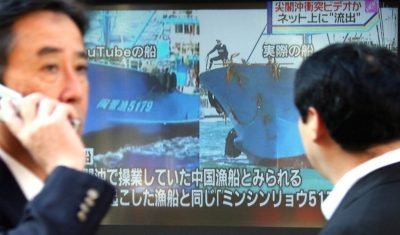The footage was released in six parts, all up 44minutes (links provided in the footer). The first three parts merely show the JCG warning (in Chinese) the Min Jin Yu that it had entered Japanese territory and to retreat from the area. A voice is heard giving the time (10:05) and location (N26 01.7, E123.37.1). In the fourth part, the collision occurs. The captain of the fishing boat, Zhan Qixiong, seems to have waited until the Yonakuni has ‘crossed his T’, (that is, was directly in front and perpendicular to the Min Jin Yu) before accelerating suddenly and steering towards the Yonakuni – Captain Zhan could have easily avoided this and there seems no question about the deliberate nature of the first collision.
The fifth section opens with the JCG Mizuki running parallel to the Min Jin Yu. Warnings are issued to ‘Stop Engine’ in Chinese, English and Japanese while a siren sounds. At 10:55am, the Min Jin Yu turns left suddenly and collides with the Mizuki’s mid-section. The sixth section is a view of the same from another JCG cutter, the Hateruma. The footage shows the Min Jin Yu apparently behaving recklessly and causing the second collision.
The location of the first incident places it inside the Provisional Measure Zone of the 1997 Sino-Japanese Fisheries Agreement (discussed here) and therefore outside its provisions for joint use of the area. This means that only the flag-state (in this case China) is permitted to arrest/detain or investigate breaches of the Agreement (although it must respond to notification from the China-Japan Joint Fisheries Committee). Japan is not permitted to take action against a boat which is suspected of a fishery violation.
But is Japan entitled to action against a boat which is behaving aggressively, with whatever provocation?
The answer to this issue is open to debate, but the answer will depend at least in part on whether Japan was acting to protect public safety at sea or to further its own narrow national interest by changing the status quo around the Senkaku/Diaoyutai islands. Clearly what is upsetting to China is that Japan’s act of boarding the Min Jin Yu and arresting Captain Zhan smacks of Japan exercising sovereign rights under Article 73 of the UN Laws of the Sea – even if Japan’s acts were not designed to change the status quo. Moreover, the decision to arrest Captain Zhan occurred nearly 12 hours after the collisions. This suggests that a deliberate decision was made to make an arrest, and that this decision was probably made by Japan’s executive (Kan Naoto and Maehara Seiji) in consultation with Ministry Foreign Affairs. Indeed, China is targeting already the Foreign Minister after his comments at Hanoi.
Although the video footage had been viewed in private by Japanese parliamentarians, the decision to release the video to the public was at the time not only pending but seemed unlikely. The subsequent leakage has left Prime Minister Kan Naoto, Foreign Minister Maehara Seiji and Defence Minister Kitazawa Toshimi to thunder impotently about investigating the source. As noted elsewhere, the effect of Kan’s handling of the issue has cost him much popular support, and this footage will damage him further.
Interestingly, one effect of the incident has not been the abandonment of 1997 Fisheries Agreement, at least not yet. The Agreement can be terminated after six months by either of the party on notice. Sengoku Yoshito has expressed his continued support for the process, and the continued existence of the Agreement provides something of symbol that the two countries still wish to return the situation to the status quo ante and get on with things. There is acknowledgement at the top that the two countries simply cannot afford to be adversaries.
View footage of the collision: 1, 2, 3, 4, 5 and 6.
Joel Rathus is a recent PhD graduate from Adelaide University and a regular contributor to the East Asia Forum.


Joel, what about the location of the second incident?